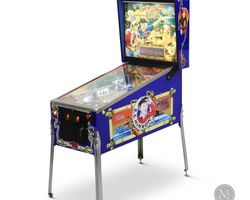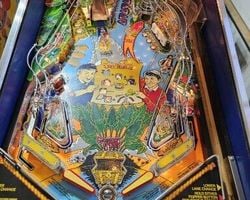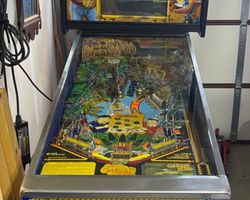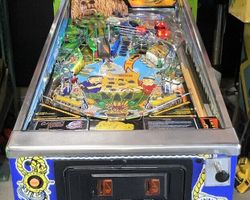Gilligan's Island
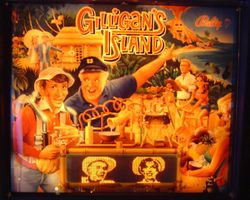
Average Prices: USD $700 to $2,600
Produced: May, 1991
Production Run: 4,100 units
Machine Type: Solid State Electronic
MPU: Williams WPC (Dot Matrix)
Players: 4
Design by: Dan Langlois, Ward Pemberton
Art by: John Youssi
Music by: Jon Hey
Sound by: Jon Hey
Software by: Mike Boon
"Gilligan's Island" represents a notable entry in the pinball machine catalog, emerging from Bally Manufacturing Co. in April 1991. The machine draws its theme directly from the popular 1960s American sitcom, a choice that tapped into a broad vein of nostalgia and recognition among players. This licensed theme allowed the game to leverage established characters and scenarios, bringing the humorous misadventures of the shipwrecked castaways to the pinball playfield.
The development of "Gilligan's Island" saw a collaborative effort from Bally's design and engineering teams. Initial concepts for the game, a departure from its eventual theme, were spearheaded by designer Dan Langlois. However, the project evolved when Ward Pemberton took the helm, shifting the focus to the "Gilligan's Island" theme. The visual identity of the machine was crafted by artist John Youssi, known for his distinctive and vibrant pinball artwork. Sound design and music, including custom speech, were managed by Jon Hey, while Tim Kitzrow provided specific callouts, notably for Mr. Howell. The software that brought the game’s mechanics and scoring to life was programmed by Dan Lee and Mike Boon, with John Newcomer handling animations for the newly introduced display technology. Greg Tastad contributed to the mechanical aspects of the machine, ensuring the physical playfield elements functioned as intended. Greg Freres was involved in a "theme support" capacity, ensuring the adaptation remained faithful to the source material.
"Gilligan's Island" marked a significant milestone for Bally and Williams (as part of the WMS Industries family) as it was the first pinball machine from these manufacturers to be released with a Dot Matrix Display (DMD). While "Terminator 2: Judgment Day" was designed with a DMD first, its longer development cycle meant "Gilligan's Island" reached production lines earlier, making it the pioneer for this display technology in the WPC (Williams Pinball Controller) system era. The machine had a production run of approximately 4,100 units, a respectable number for its time. Beyond its display innovation, the design process also included practical improvements, such as a redesigned coin door latch intended to prevent general illumination shorts and a revised, single-piece ball popper mechanism to enhance durability and reduce mechanical issues.
Signature Features and Design
The "Gilligan's Island" pinball machine incorporates several distinctive elements that define its gameplay and aesthetic. A prominent feature is the rotating "Jungle Run" circular platform positioned in the upper-left corner of the playfield. This mechanism dynamically reconfigures ball lanes, altering the trajectory of the pinball as it enters and exits, which creates a sense of unpredictability and keeps players engaged with changing shot opportunities. Complementing this, the game features a moving island and a volcano, which are visual anchors that contribute to the immersive tropical theme.
The visual design is enhanced by John Youssi's artwork, which renders the familiar characters and setting of the TV show in a lively, colorful style. The playfield teems with caricatures of Gilligan, the Skipper, and the rest of the castaways, amidst lush jungle foliage and beach scenes, all contributing to the machine’s lighthearted disposition. The use of the Dot Matrix Display, while a technical innovation for the manufacturer, supported visual feedback for scoring and mode progression, presenting simple animations and character expressions. The machine also includes a crucial kickback mechanism for the middle-left lane and the left outlane, offering players a chance to save a drained ball, adding a layer of strategic play beyond pure shot making. These features collectively enhance the gameplay, integrating thematic elements with mechanical innovation to provide a cohesive experience.
Playfield and Mechanics
The playfield layout of "Gilligan's Island" is designed with an emphasis on approachable gameplay, allowing both newcomers and seasoned players to quickly understand its objectives. Central to the scoring strategy is the single ramp, positioned prominently, which serves as a primary shot throughout the game, particularly during scoring sequences related to the "Kona" objective. The playfield also features fourteen standup targets, strategically placed to represent "ingredients" that players must collect to advance game modes.
Three pop bumpers are situated in the upper portion of the playfield, contributing to chaotic ball movement and offering opportunities for incidental points. Two slingshots flank the lower playfield, providing reactive redirection of the ball. A kick-out hole and a Vertical Up-Kicker are integrated into the layout, leading to specific awards or initiating ball returns to upper playfield areas. The "Jungle Run" circular platform actively modifies ball paths, dictating how the ball exits that area of the playfield.
The overall flow of the game is linear and straightforward, encouraging players to hit illuminated targets to collect ingredients before directing shots towards the main ramp. This design philosophy aimed for clarity and immediate accessibility, ensuring players understood their next objective. The artwork, consistent with John Youssi's style, is bright and directly represents scenes and characters from the television series, enhancing player immersion through visual familiarity. Lighting on the playfield is used to guide players, highlighting active shots and indicating progression through modes, ensuring critical objectives are clearly visible.
Gameplay Dynamics
"Gilligan's Island" features a gameplay structure centered around collecting specific items and executing a primary shot for significant scoring. The fundamental objective is to "get the ingredients" by hitting various standup targets across the playfield, then "shoot the ramp" to capitalize on accumulated value. This progression leads to collecting items for "Lava Seltzer" and ultimately shooting the ramp for "Kona" for substantial point accrual.
The game includes a two-ball multiball, activated specifically through a "lucky lagoon award," which introduces an element of chance to its initiation. During multiball, ramp shots become particularly valuable, awarding 1 million points per shot, creating a focus for players once multiball is active. Scoring in "Gilligan's Island" can exhibit a degree of imbalance; some shots, like a particular "stupid 50M shot" (as noted in community discussions), can disproportionately reward players compared to other efforts. "Jungle Runs," while adding dynamic ball movement through the rotating platform, typically max out at 5 million and 2.5 million points, making them less lucrative than the primary ramp shots.
A critical element of gameplay is the kickback feature, essential for recovering balls from the outlanes. Advancing the kickback value can lead to bonus balls, though the kickback value can be reset after a bonus ball is achieved, requiring players to re-qualify it. The skill shot, an important saucer shot accessible at the start of each ball, also functions as the bonus-x shot, encouraging precision plunges for score multiplication. The game’s objectives are largely sequential, maintaining a clear path for players to follow.
Reception and Legacy
"Gilligan's Island" elicits a range of opinions within the pinball community, demonstrating a clear divide between those who value nostalgic appeal and simplicity, and those who seek deeper, more complex gameplay. For casual players and fans of the source material, the machine is frequently described as a "fun" experience, offering an approachable entry into pinball. Its direct connection to the television show is a significant draw, contributing to an enjoyable and often family-friendly playing session. The rotating island and turntable mechanisms are often cited as engaging features that add a dynamic, if sometimes predictable, element to the playfield. The artwork, generally considered good to very good, and the music, while dated, contribute positively to the thematic immersion. Many consider it a good starting point for new players due to its straightforward rules.
However, more experienced pinball enthusiasts often highlight the machine's weaknesses, primarily its shallow ruleset. Critics frequently describe the gameplay as linear and lacking in depth, leading to a repetitive experience over extended play sessions. The random nature of the multiball activation via the lagoon award is also a point of contention, as it removes player agency in initiating a major scoring opportunity. Scoring is sometimes viewed as unbalanced, with a few high-value shots overshadowing other playfield elements, reducing strategic diversity. The Dot Matrix Display, while a pioneering feature for its manufacturer, is often noted for being underutilized, with limited animations or interactive elements that fully exploit its capabilities. Furthermore, some find the audio quality underwhelming and certain sound effects repetitive or even annoying over time.
Despite these criticisms, "Gilligan's Island" holds a place in pinball history as the first WPC machine from Bally/Williams to be released with a DMD. Its influence lies not in complex rule sets, but in its role as a bridge for new display technology and its successful leveraging of a well-known license to attract a broad audience. While it may not feature among the deepest or most strategically demanding machines of its era, its appeal to a specific segment of players, particularly those with a fondness for the original television series, has ensured its continued presence and discussion within the pinball community.
Sponsored Links
 Ebay Listings
Ebay Listings
 Auction Results
Auction Results
| Cost | Location | Date |
|---|---|---|
| USD $3,300 |  Massachusetts, United States Massachusetts, United States |
28 October, 2025 |
| USD $5,000 |  California, United States California, United States |
27 June, 2025 |
| USD $3,200 |  Virginia, United States Virginia, United States |
03 March, 2025 |
| USD $3,000 |  California, United States California, United States |
11 September, 2024 |
| USD $3,200 |  New York, United States New York, United States |
29 July, 2024 |
| CAD $8,500 |  Canada Canada |
11 May, 2024 |
| USD $6,999 |  California, United States California, United States |
22 October, 2023 |
| USD $2,600 |  California, United States California, United States |
04 August, 2023 |
| USD $4,500 |  Minnesota, United States Minnesota, United States |
24 July, 2023 |
| USD $4,599 |  Pennsylvania, United States Pennsylvania, United States |
03 May, 2023 |


Private Policy · Search Website · Contact Us
As an eBay Partner, we may earn a commission from qualifying purchases made through links on this site, at no additional cost to you.
All trademarks and copyrighted materials remain property of their respective owners. All other content copyright 2007 - 2025 Pinpedia.

